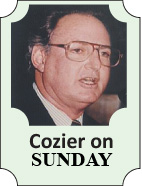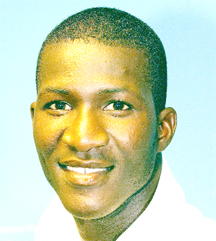As galling as it may be, it is impossible to quibble with the International Cricket Council’s (ICC) positioning of the West Indies as ninth among the 14 contestants in the 10th World Cup that began yesterday with India confirming their rank as favourites with their comfortable, high-scoring, away victory over co-host Bangladesh.
Once the mightiest, most feared team in the game, the unbeaten champions in the first two tournaments have sunk below even the hapless Bangladeshis who only rose from their accustomed position at the bottom of pack a fortnight ago, at their expense.
So, for the game’s most prestigious event, the West Indies now find themselves in the company of Canada, Kenya, Ireland, the Netherlands and Zimbabwe, teams not considered worthy even of Test status, still the game’s benchmark.
 The basis of their demotion is clear.
The basis of their demotion is clear.
They last prevailed in a series over more highly rated opponents almost three years ago, 2-0 at home to Sri Lanka in April, 2008, since which they have been twice whitewashed by Australia and South Africa, home and away. Their only six wins in 20 matches in the past 12 months were over Zimbabwe (4), Canada and Ireland.
Such woes have been mainly of their own making. They have been principally caused by the mistrust and constant bickering between the West Indies Cricket Board (WICB) and their West Indies Players Association (WIPA) that led to two players’ strikes and, more recently, by the refusal of WICB contracts by two of their major players, Chris Gayle and Dwayne Bravo.
That decision eliminated them from their incumbent roles as captain and vice-captain and thrust Darren Sammy, an enthusiastic but limited cricketer not previously sure of his place, into the leadership by default.

To compound the problems, injuries that kept their two major fast bowlers, Fidel Edwards and Jerome Taylor, from selection here have struck down Adrian Barath, the exciting young opener, and Carlton Baugh, the wicket-keeper, on the eve of the Cup. Kirk Edwards and Devon Thomas, two fledglings on their first missions in an unfamiliar land, have been summoned as replacements.
Such a recitation of woes is not so much pessimistic as realistic.
Taken all together, they convey as much chance of Sammy raising the Cup at Mumbai’s Wankedhe Stadium on April 2 as Kapil Dev did for India at Lord’s in 1983. Even getting to the semi-final would be a triumph.
But it is the glorious game’s such unpredictably that gives the West Indies hope, however slim it might seem.
India began that third Cup with an indifference, if not an aversion, to what they perceived as an abomination of the real, traditional game. It was reflected in their five losses against one win (over East Africa) in the two previous tournaments.
All that changed under the influence and all-round brilliance of Kapil Dev. Seemingly journeyman cricketers like Roger Binny, Madan Lal and Balwinder Singh Sandhu played above themselves and a united team upset the seemingly invincible West Indies, Australia and England in the early rounds before punishing the West Indies’ complacency in the final.
India’s was a triumph as unexpected as any in a world championship final in any sport.
Four years later, Australia, under Alan Border, Kapil’s inspirational counterpart, emerged from a trough of unaccustomed mediocrity to win the trophy the first time it was staged in these parts.
Sri Lanka, under Arjuna Ranatunga, an audacious skipper undaunted by his team’s underdog tag and willing to take outrageous risks, followed suit in the sub-continent’s second World Cup in 1996.
As player, Sammy is no Kapil, Border or Ranatunga. On merit, he might not even be here had not Gayle and Bravo gone their freelance way. In the short time he has been at the helm, his cricket has seemingly suffered from the responsibility of leadership.
For the West Indies to confound its ranking, he must overcome his own self-doubt, a condition that has engulfed the team as a whole with every passing loss, and be as assertive and adventurous in his tactics as Ranatunga.
Man for man, the West Indies are well behind the strong, well balanced units of India, South Africa and Sri Lanka, the three most favoured. They are short of the self-belief of the Australians, for all their trouncing by England in the Ashes Test series.
Innovative planning could narrow the gap. There is surely nothing to lose, all to gain.
The introduction of the third power-play, for instance, limiting the field to three outside the inner ring for five overs of the batting team’s choice, is open to exploitation for clean hitters like Chris Gayle, Kieron Pollard and Dwayne Bravo to exploit – but only when properly timed.
The reading of the different pitches, the choice of bowlers and bowling changes and the possible effect of dew in the northern cities such as Delhi and Mohali are factors to be carefully considered by the think tank of Sammy, coach Ottis Gibson and senior players who have prior experience of India.
Using the spin of Sulieman Benn with the new ball (a move that New Zealand adopted to telling effect with off-spinner Dipak Patel in 1992) is clearly an option. On the slow, low pitches expected, so is the inclusion of both Benn and the other left-arm spinner, Nikita Miller, in the final 11 and the use of Gayle’s steady off-spin for all his allocated 10 overs.
With Barath now out (the fourth time he has had to withdraw through injury or illness, a worrying trend), the batting order is also open to tweaking.
It is worth considering moving Shivnarine Chanderpaul, in what is certainly his last appearance on this particular stage, back up to open where he has made most of his ODI runs.
On surfaces unlikely to bounce much more than stump high and, in any case, with umpires strict on height, it is worth exposing Pollard down the list to do what he so spectacularly, and profitably, did on many of these grounds in the Indian Premier League (IPL). His off-the-pace bowling and ground fielding are other factors to press his case. The change in the tournament’s format splits the 14 teams into two qualifying groups. The top four in each go into the quarter-finals after which it is a knockout lottery on the way to the Mumbai final.
Their lowly ICC ranking places the West Indies in the group that includes India, South Africa (their first opponents on Thursday in Delhi) and England, all of whom are expected to move on. The others are Bangladesh, Ireland and the Netherlands.
The certainty is that, on a good day, the West Indies can overcome all of them just as, on a bad day, they can lose to all. And the bad days have far outnumbered the good for the better part of a decade now.
On the face of it, the clincher is likely to be the match against Bangladesh in Mirpur on March 4 but that presumes they don’t slip on the banana skins that are the Netherlands (February 28) and Ireland (March 11).
The coming month might just provide a welcome boost for West Indies cricket and for captain Sammy – but then again it might be vice-versa. Stay tuned.





